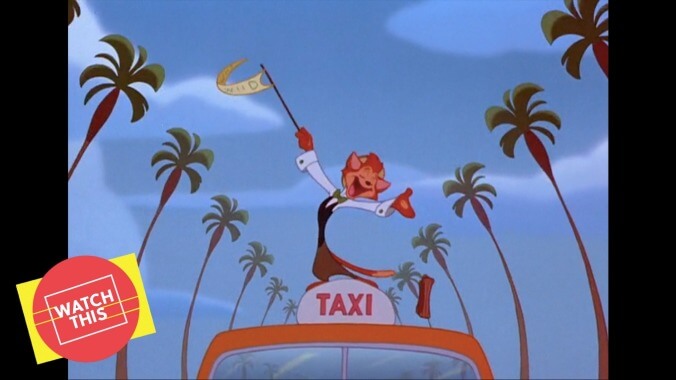Cats Don’t Dance should have kicked off a golden age of Warner Bros. animation

Watch This offers movie recommendations inspired by new releases, premieres, current events, or occasionally just our own inscrutable whims. This week: With Raya And The Last Dragon, the new SpongeBob movie, and the half-cartoon Tom And Jerry all available this week, we’re looking back on some of the most under-appreciated family-friendly animation.
Cats Don’t Dance (1997)
One of the strangest longterm failures of the Warner Bros. studio is its inability to parlay its decades-long short-form cartoon success from the ’30s through the ’50s (not to mention its substantial TV animation success in later years) into a viable feature animation department. The company made a go of it back in the ’90s, and looking at that output now, it feels like Warner Bros. was onto something before the Disney-aping bomb Quest For Camelot helped sink the division for decades. Other productions of this era include the beloved Batman: Mask Of The Phantasm, the now-classic The Iron Giant, and the 1997 obscurity Cats Don’t Dance.
Technically, Cats Don’t Dance was only distributed by Warner Bros.; it was the sole full feature produced by Turner Animation before a merger absorbed the nascent studio into its new corporate parent. But it’s extremely compatible with Warner’s history, not least because it features at least a dozen caricatures of the types of Old Hollywood celebrities that used to dot classic Looney Tunes and Merrie Melodies. It’s even set in 1939, right around the creation of Bugs and Daffy, in an alternate Hollywood where talking animals intermingle with human stars, though they aren’t ever given leading roles. Danny (Scott Bakula) isn’t aware of this limitation, so he takes the bus from his Indiana hometown all the way to Hollywood with visions of becoming a feline movie star.
Danny does get cast right away—as a cat in a Noah’s Ark musical, opposite human child star Darla Dimple (Ashley Peldon), whose ultra-sweet image belies her monstrous ego and hatred of animals. This leads to Danny, another cat named Sawyer (Jasmine Guy), and a passel of animal performers squaring off against Darla as they agitate for the chance to prove themselves as entertainers. It sounds like standard underdog-dreamers-band-together kiddie movie stuff, and plotwise, that’s about what it is. Cats Don’t Dance has all the hallmarks of old-school family-friendly animation: cute animals, a slim 75-minute running time, and obligatory songs (written by a post-Toy Story, pre-every-other-song-he-wrote-for-Pixar Randy Newman). It could almost pass for a lost Disney project circa 1987 or so.
What separates the movie from so many other warmed-over Disney knockoffs is its springy, whimsical animation style and nods to various films of its period, from those Looney Tunes-style celebrity sight gags to passages of fast-paced screwball dialogue. Like a lot of classic Warner shorts, it weaves its appeal to kids and adults together tightly, trusting the latter will appreciate its verbal and visual wit (and also not presuming the former won’t). And unlike a lot of Disney films of this era, Cats Don’t Dance is unburdened with the expectations that it could top something like The Lion King in grandeur; it feels less obligated to go “Big And Loud,” as the movie’s best, nuttiest musical number advocates. It’s a villain song performed by Darla Dimple, who exemplifies the film’s visual craft. She’s a fun bad guy to watch because the animators work her up into white-hot tantrums and give her a monstrously oversized valet to do her bidding. So many feature cartoons of this era operate under formula constraints; the animation of Cats Don’t Dance often feels exuberantly free.
Director Mark Dindal worked at Disney before and after Cats Don’t Dance, and went on to direct The Emperor’s New Groove—probably not coincidentally, one of the studio’s most distinct and personality-driven projects. Animation fans who haven’t seen this one will be relieved to find that Dindal’s first film has a lot more in common with Groove than his misbegotten Disney follow-up Chicken Little—a potent reminder that authorial voice can still emerge from studio animation under the right circumstances (and can still get smothered in plenty of others). For that matter, Cats Don’t Dance is vastly preferable to another, better-known caterwauling musical, too.
Availability: Cats Don’t Dance is available for digital rental or purchase from Amazon, Google, YouTube, Microsoft, and VUDU. Warner Bros. really ought to stick it on HBO Max.